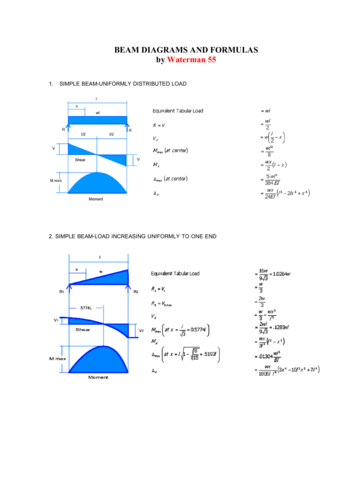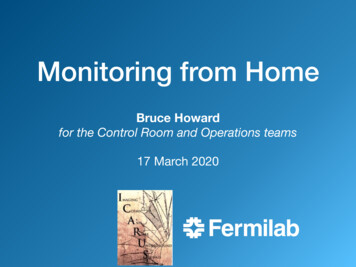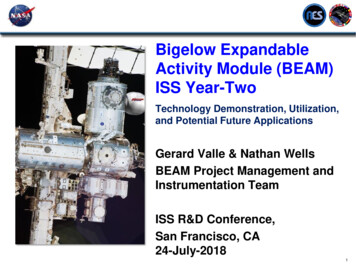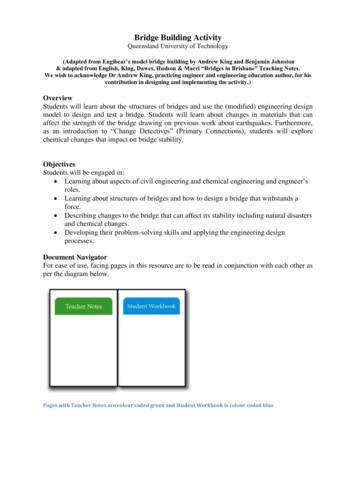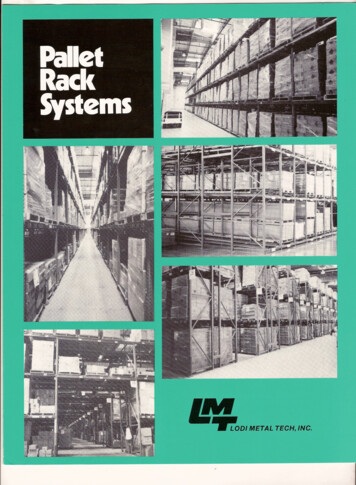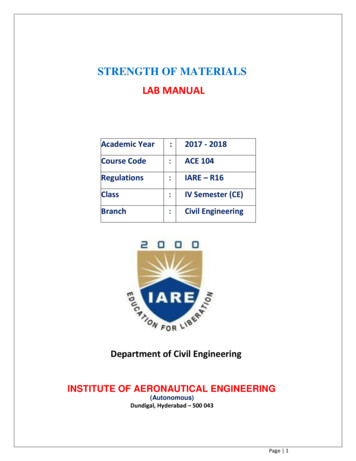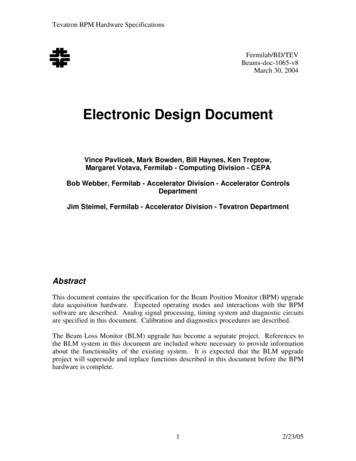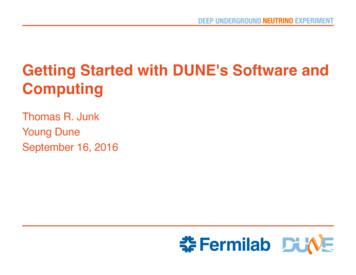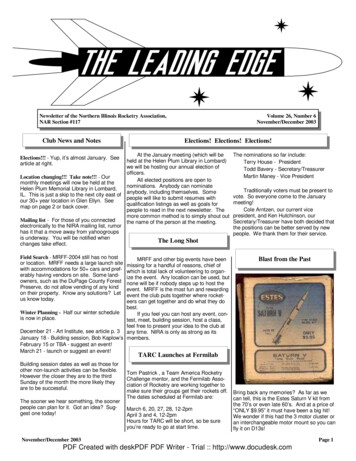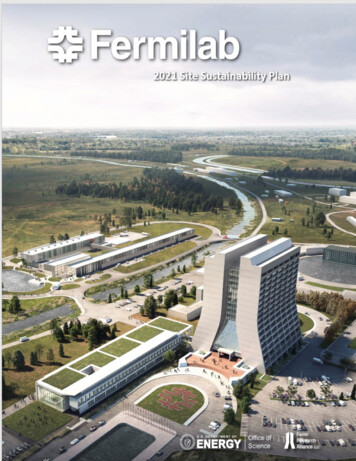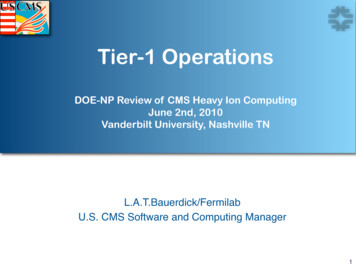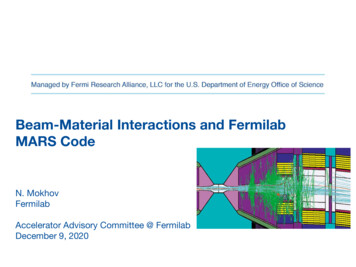
Transcription
Beam-Material Interactions and FermilabMARS CodeN. MokhovFermilabAccelerator Advisory Committee @ FermilabDecember 9, 2020
AAC Charge Questions Addressed in the PresentationBeam Energy Deposition and Fermilab MARS Code:Assess the Fermilab’s effort in beam energy deposition andparticle/radiation production modeling. What are the long-term plansfor this effort? Is the MARS code effort adequate to sustain futureFermilab program demands?This presentation reminds what MARS is, describes recent effortson the code development and MARS applications to the majorFermilab projects, long-term plans as well as challenges and pathforward to sustain future Fermilab program demands.2AACN. Mokhov Beam-material interactions and Fermilab MARS code12/09/2020
Beam-Matter Interaction SimulationsThe consequences of controlled or uncontrolled impacts of highintensity or/and high-power or/and high-energy beams oncomponents of accelerators, beamlines, target stations, beamcollimators, absorbers, detectors, shielding, and environment canrange from minor to catastrophic.All forces govern beam interactions with complex components inpresence of electromagnetic fields simulations are only possiblewith a few well-established Monte-Carlo codes: FLUKA andMARS15 being the leaders in full-scale accelerator applications.Due to the extensive use of these codes in numerous applicationsand massive benchmarking the simulations have reached anunprecedented accuracy.3AACN. Mokhov Beam-material interactions and Fermilab MARS code12/09/2020
MARS Code SystemThe MARS code system is a set of Monte Carlo programs fordetailed simulation of coupled hadronic and electromagneticcascades, with heavy ion, muon and neutrino production andinteractions, in an arbitrary geometry of shielding, accelerator,detector and spacecraft components.Current MARS15 combines well established theoretical modelsand databases for strong, weak and electromagnetic interactionsof hadrons, heavy ions and leptons with a system.Especially powerful in accelerator lattice, beamline andmachine-detector interface applications.It was originated by NM at MEPhI (Moscow), and developed sinceat IHEP (Protvino), SSCL (Texas) and Fermilab.300 official users & 40 sites worldwide, https://mars.fnal.gov4AACN. Mokhov Beam-material interactions and Fermilab MARS code12/09/2020
MARS15 Key Features A model can be built out of a million objects ranging in dimensions frommicrons to hundreds kilometers in the same setup with up to 500composite materials, with arbitrary 3-D magnetic and electric fields. Recently developed powerful integrated MARS-MADX-PTC system (nowin beta-tests) is highly-efficient for particle tracking in SRF (with timedependent electromagnetic fields and Dark Current production),quadrupole and dipole magnets and Machine-Detector Interface for use inthe 10-5 eV E 100 TeV energy range. Semi-automated (currently) use of CAD models, bilateral geometry modelexchange (GDML format) with Geant4, nuclide production, decay,transmutation and calculation of the activity distribution with the built-inDeTra code, accurate radiation damage calculations based on theoreticalmodels and the newly generated cross-section database. User-friendly Graphical-User Interface (GUI), various tagging, biasing andother variance reduction techniques, and hydrodynamic tunneling.5AACN. Mokhov Beam-material interactions and Fermilab MARS code12/09/2020
MARS Use and Support The code is installed and supported on 40 MARS sites: at the DOE Labs,US universities, CERN, PSI, GSI, ESS, KEK, J-PARC, RIKEN, severalJapanese Universities, Korean PAL etc. At Fermilab, MARS is installed, supported and used on the AD MARSclusters (heimdall, heimdallr, gulltoppr and thudpucker), and Fermigrid(marslbnf, marsmu2e, marsgm2, marsaccel and marspip2 groups) At Argonne Leadership Computing Facility (ALCF supercomputing,petaflop platform) Protected by the DOE Copyright and MARS User’s Agreement User’s Guide – need substantial update (need to find time to do that) Regular (in the past) MARS tutorials in US and worldwide All of the above – free of charge, some changes are possible - underconsideration with Office of Partnership and Technology Transfer6AACN. Mokhov Beam-material interactions and Fermilab MARS code12/09/2020
MARS Group Five PhD holders (theor & math physics, physics of atomic nucleiand elementary particles, nuclear engineering, beam physics &accelerator techniques, simulations of solar and stellar convectionand oscillations) and systems admin III/computer professional VI. Knowledgeable and experienced in MARS use, with four currentlycapable in development of its modules. The group member’sexpertise is in great demand in AD, projects and other applications. Predominantly, work for accelerator and experiment projects:targetry and particle production, beam loss/collimation, shieldingdesign and verification, radiation loads, heating and damage,shielding assessments etc. MARS is an integral part of that process, with not much timeremained for its general long-term developments, documentationand tutorials; mainly, immediate application-driven needs (e.g.,recent H- beam and processes in SRF etc.)7AACN. Mokhov Beam-material interactions and Fermilab MARS code12/09/2020
MARS Mission Increase physics output by maximizing useful particle yields fromtarget systems and minimizing backgrounds in detectors Model 3D distributions of particle flux, energy deposition density,prompt and residual doses, nuclide production, radiation damageand spectra by primary and secondary beams for complexaccelerator and detector configurations Optimize performance of those predictive virtual particleaccelerators and experimental setups Ensure safe designs and operations of accelerator systems andexperiments Make MARS even more capable, trustable and usable in practicallyarbitrary parameter phase space8AACN. Mokhov Beam-material interactions and Fermilab MARS code12/09/2020
MARS15 (Fermilab) Applications9AACN. Mokhov Beam-material interactions and Fermilab MARS code12/09/2020
MARSLBNF and MARSMu2eLBNF Hadron Absorber complexPrompt dose map (mSv/hr)Mu2eSeveral years of efforts to optimizewith MARS15 the Mu2e Production,Transport and Detector solenoidsystems w.r.t. their performance,lifetime, shielding and costLBNF Hadron AbsorberResidual dose map (mrem/hr) 100/410AACN. Mokhov Beam-material interactions and Fermilab MARS code12/09/2020
Newest MARS15-MADX-PTC Integration Cross-talk of MAD-X PTC module with MARS geometry and tracking ones Arbitrary boundary conditions and cross-talk points. A library containing functions and C classes which interfaces MARSwith MADX is now packed with the MARS15 distribution. For particles transported in PTC, check is performed of boundary crossingagainst the ROOT geometry in MARS15; the particle is forwarded to theMARS15 stack. 3-D TGeo ROOT geometry model is created for the sequence describedin a MADX-PTC input file. Alignment of elements is performed by meansof the MAD-X survey table.Beam orbits in the Fermilab 8-GeVRecycler calculated with MAD-X PTCmodule (blue) and MARS15 nativestepper (red)11AACN. Mokhov Beam-material interactions and Fermilab MARS code12/09/2020
New PIP-2 Booster CollimationMARS-MADX-PTC Fusion Allows Effective Use of both ABPand Particle-Matter Interaction Code Strengths (1)12ResDose (mrem/h)3s 800-MeV proton tracksAACN. Mokhov Beam-material interactions and Fermilab MARS code12/09/2020
PIP-2 Linac, BTL and Beam TestMARS-MADX-PTC Fusion Allows Effective Use of bothABP and Particle-Matter Interaction Code Strengths (2)BTLHB650LB6501s H- trajectoriesQuadsGood agreement with TraceWinSSR2S (m)13AACN. Mokhov Beam-material interactions and Fermilab MARS code12/09/2020
MARS Geometry Models Capture Realistic CAD Details:PIP-2 Linac and BTLBTL QuadHB650Linac & BTLCADCADCADMARS14AACMARSN. Mokhov Beam-material interactions and Fermilab MARS codeMARS12/09/2020
MARS-MADX-PTC: Reliable Simulation of H- Beam Loss-InducedRadiation Loads as well as Prompt and Residual Dose MapsPrompt Dose (mrem/hr) residual dose, radiation loads and damage1 W/m operational beam loss rate, Elevation view15AACFull beam accident (3 sec), X-Y viewRF waveguide penetrationsN. Mokhov Beam-material interactions and Fermilab MARS code12/09/2020
Delivery Ring Model & Consistent Beam Loss SimulationsES Septum8 GeV, 100 tracks, 4 turnsMARS15-MADX-PTCES116AACLambertsonES2N. Mokhov Beam-material interactions and Fermilab MARS code12/09/2020
Challenges and Path Forward (generic) Perfecting predictive virtual accelerator and experiment models Further development of SRF modules with all the underlying physics Creation of CAD - MARS ROOT - CAD user-friendly geometryconverters compatible with strict requirements to simulation inchallenging accelerator environment - DOE grant in collaboration withsmall business company User-friendly module to calculate 3D residual dose maps aroundaccelerator equipment in tunnel and other enclosures, with 3D GUI DOE grant in collaboration with small business company There is an interest from Geant4 in collaboration with MARS The MARS group needs additional physicist - expert in acceleratorapplications and code development; the present group isoversubscribed and currently has minimal time for development andsupport17AACN. Mokhov Beam-material interactions and Fermilab MARS code12/09/2020
Challenges and Path Forward (more technical) Implement modern code-management techniques, andflatten codebase (Fortran & C , Hbook & ROOThistograms etc) MPI (message-passing interface) and multiple-core jobs(standard for two decades): 102 to 105 cores routinely;improved submission scripts and built-in averaging Minimize a loss in scalability with # of MPI ranks 4 104on the current petaflop (1015 fpo/s) platform and prepareto the exascale (1018 fpo/s) computing era Eliminate code distribution, export control and userinstallation issues Update and modernize the MARS User’s Guide Restore the earlier MARS practice of regular tutorials18AACN. Mokhov Beam-material interactions and Fermilab MARS code12/09/2020
Challenges and Path Forward (ABP for MARS) Develop a definition and requests to predictive virtualparticle accelerators Develop beam loss models for linear and circularaccelerators and colliders usable in particle-matterinteraction codes Develop beam halo models for particles hitting the limitingapertures (primary collimators, ES-septa etc.) Establish collaboration with accelerator tracking codedevelopers on better x-talk algorithms (preserving allphysics and providing the highest accuracy and computingefficiency) between their codes (MAD-X PTC) and particlematter interaction codes (MARS)19AACN. Mokhov Beam-material interactions and Fermilab MARS code12/09/2020
Conclusion The MARS group and code are important to Fermilaband the community. There are several recentimpressive developments, with further enhancementsstill possible. There are some risks going forward –adequate team for expertise, performance,documentation and maintaining the code. Focus on 20AACFurther code modernizationUser-friendly CAD to MARS geometry model converterCode managementUser’s Guide update and tutorialsModernization of legal forms and export control issuesN. Mokhov Beam-material interactions and Fermilab MARS code12/09/2020
Backup Slide: MARS for LHC and HiLumi LHC MARS simulations since 1998 helped design the optimal high-luminosityInteraction Regions IR1 and IR5 of LHC, including their TAS, TASB andTAN absorbers, and predict superconducting magnet short-term (quenchstability) and long-term (lifetime) performances (e.g., N.V. Mokhov et al.,Protecting LHC IP1/IP5 Components Against Radiation Resulting fromColliding Beam Interactions, Fermilab-FN-732 (2003), LHC ProjectReport 633, CERN (2003)) “MARS predictions of 16 years ago of energy deposition in thelow-beta quads agree within 20% with recent measurements inthe real LHC machine. No beam-induced quench has beenobserved at LHC”. Lucio Rossi, talk at Fermilab, February 2014 Note that two decades ago there was no collider experimental dataabove 1 TeV to verify the code’s physics models. These days – workingon the HiLumi LHC upgrade - we have a luxury of coherent studies withthe FLUKA and MARS codes benchmarked in the TeV energy region.21AACN. Mokhov Beam-material interactions and Fermilab MARS code12/09/2020
Colliding Beam Interactions, Fermilab-FN-732 (2003), LHC Project Report 633, CERN (2003)) "MARS predictions of 16 years ago of energy deposition in the low-beta quads agree within 20% with recent measurements in the real LHC machine. No beam-induced quench has been observed at LHC". Lucio Rossi, talk at Fermilab, February 2014
